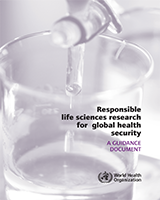All rights reserved. Publications of the World Health Organization can be obtained from WHO Press, World Health Organization, 20 Avenue Appia, 1211 Geneva 27, Switzerland (tel.: +41 22 791 3264; fax: +41 22 791 4857; e-mail: tni.ohw@sredrokoob). Requests for permission to reproduce or translate WHO publications – whether for sale or for noncommercial distribution – should be addressed to WHO Press, at the above address (fax: +41 22 791 4806; e-mail: tni.ohw@snoissimrep).
NCBI Bookshelf. A service of the National Library of Medicine, National Institutes of Health.
Responsible Life Sciences Research for Global Health Security: A Guidance Document. Geneva: World Health Organization; 2010.

Responsible Life Sciences Research for Global Health Security: A Guidance Document.
Show detailsThe prototype oversight system, known as the Biological Research Security System, developed by the Center for International and Security Studies (CISSM) at the University of Maryland, USA, rests on two key elements: national licensing of personnel and research facilities and independent peer review of relevant projects before their initiation. As the table on “Illustrative categories of research activities” shows, for the activities of extreme concern, there would be a global standard setting and review body – the International Pathogens Research Authority. This body would oversee those activities and would be in charge of defining the research activities falling under the different categories of oversight. At the next level, there would be a national review body – the National Pathogens Research Authority – to oversee activities of moderate concern. The national body would also oversee the work of local review bodies and the licensing of researchers and facilities. Finally, the local review body – the Local Pathogens Research Committee – would be in charge of overseeing activities of potential concern. According to CISSM, most of the microbiological research would either fall under this last category or not be covered at all.
Illustrative Categories of Research Activities
| ACTIVITIES OF EXTREME CONCERN (AEC) |
|---|
| Work with eradicated agents;a work with an agent assigned as BL-4/ABL-4; de novo synthesis of above; expanding the host range of an agent to a new host (in humans, other animals and plants) or changing the tissue range of a listed agent;b construction of antibiotic- or vaccine-resistant listed agent. |
| ACTIVITIES OF MODERATE CONCERN (AMC) |
| Increasing virulence of listed agent or related agent; insertion of host genes into listed agent or related agent; increasing transmissibility or environmental stability of listed agent or related agent; powder or aerosol production of listed agent or related agent; powder or aerosol dispersal of listed agent or related agent; de novo synthesis of listed agent or related agent; construction of antibiotic- or vaccine-resistant related agent; genome transfer, genome replacement, or cellular reconstitution of listed agent or related agent. |
| ACTIVITIES OF POTENTIAL CONCERN (APC) |
| Work with listed agents – or exempt avirulent, attenuated, or vaccine strain of a listed agent – not covered by AEC/AMC; Increasing virulence of non-listed agent; increasing transmissibility or environmental stability of non-listed agent; powder or aerosol production of non-listed agent; powder or aerosol dispersal of non-listed agent; de novo synthesis of non-listed agent; genome transfer, genome replacement, or cellular reconstitution of non-listed agent. |
- a
This would include, for example, activities with the 1918 influenza virus and chimeric influenza viruses with at least one gene from the 1918 influenza virus.
- b
This would include, for example, activities with chimeric influenza viruses with at least one gene from a human influenza virus and at least one gene from an avian influenza virus.
Table Definitions
Agent: fungus, protozoan, bacterium or archaeon, virus, viroid, or prion; or genetic element, recombinant nucleic acid, or recombinant organism.
Listed Agent: agent on CDC Select Agent list, USDA High-Consequence Livestock Pathogens list, or USDA/ APHIS/PPQ Plant Pathogens list.
Related agent: for fungi, protozoans, or bacteria or archaea, an agent that currently is, or in the last two years was, assigned to the same genus as a listed agent; for viruses, viroids, or prions, an agent that currently is, or in the last two years was, assigned to the same family as a listed agent; for genetic elements, recombinant nucleic acids, or recombinant organisms, an agent orthologous to a listed agent. (This includes any avirulent, attenuated, or vaccine strain of a listed agent, if said strain is exempt under the CDC Select Agent list, USDA High-Consequence Livestock Pathogens list, or USDA/APHIS/PPQ Plant Pathogens list.)
Non-listed agent: agent other than a listed agent or related agent.
Eradicated agent: agent previously in circulation in nature but not within the last decade, as determined by cases of or isolation from humans, animals, or plants, or by detection of antibodies to the agent from individuals younger than the time-span elapsed since the last recorded isolation.
De novo synthesis: construction of agent using synthetic genomic nucleic acid (non-prion agents) or synthetic protein (prions), irrespective of whether said construction require additional reagents, extracts, cells, or ‘helper’ entities. For purposes of this definition, ‘synthetic genomic nucleic acid’ refers to nucleic acid that corresponds to an agent genome and that is prepared using, in any step or set of steps, chemically synthesized oligonucleotides, corresponding to at least 5% of said agent genome.
Powder: powder other than lyophilized reference specimen (<10 mg).
Antibiotic: antibiotic of therapeutic utility against listed agent.
Vaccine: vaccine of therapeutic utility against listed agent.
Source: Steinbruner J, et al. Controlling dangerous pathogens. A prototype protective oversight system. The Center for International and Security Studies at Maryland (CISSM), The University of Maryland; College Park, Maryland: Mar, 2007.
Footnotes
- 1
Steinbruner J, et al. Controlling dangerous pathogens. A prototype protective oversight system. The Center for International and Security Studies at Maryland (CISSM), The University of Maryland; College Park, Maryland: Mar, 2007.
- A model from the Center for International and Security Studies - Responsible Lif...A model from the Center for International and Security Studies - Responsible Life Sciences Research for Global Health Security
Your browsing activity is empty.
Activity recording is turned off.
See more...